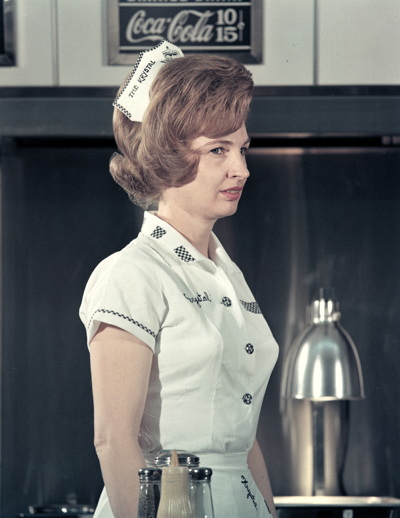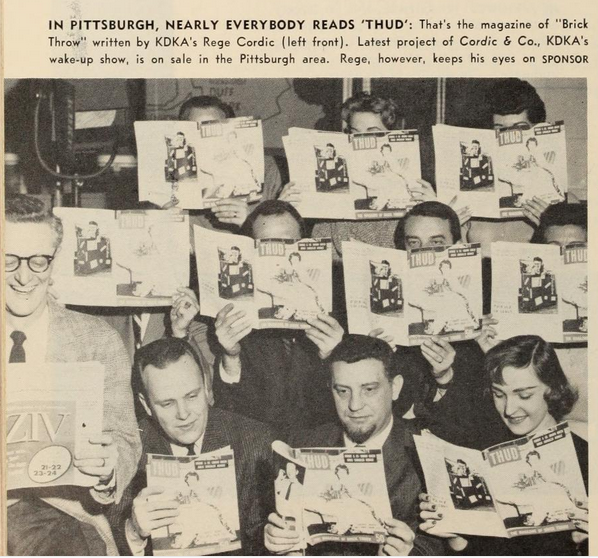1950s
The Trapp Family
Before there was The Sound of Music there was...Die Trapp-Familie?!? The whole movie is below, with English subtitles.The Wikipedia page for this 1956 German production.
Posted By: Paul - Thu May 09, 2024 -
Comments (0)
Category: Movies, Debuts, Christenings, Launches and Reboots, 1950s, Europe
Good Waitress, Bad Waitress
Stills from a 1950s-era film made to train waitresses at Krystal restaurants.
Bad Waitress
Info from the Chattanooga Times:
Chattanooga-based Continental Films deployed the Bad Waitress in films and slideshows during the 1950s and early 1960s to teach Krystal employees how to give excellent customer service. (Yes, Krystal once had waitresses.)
The same actress returns as a nonsmoking Good Waitress wearing a spotless uniform. Her hair is swept into a neat bouffant, her eyebrows perfectly plucked and her makeup is modest. She even smiles demurely.

Good Waitress
The film was part of a collection donated to the Chattanooga History Center. But I don't think they've put the film online yet.
Posted By: Alex - Wed May 08, 2024 -
Comments (0)
Category: Movies, Restaurants, 1950s
One Little Indian
One Little Indian, Grant Munro, provided by the National Film Board of Canada
Posted By: Paul - Wed May 08, 2024 -
Comments (0)
Category: Highways, Roads, Streets and Traffic, Magic and Illusions and Sleight of Hand, PSA’s, Stop-motion Animation, 1950s, North America, Native Americans, Circuses, Carnivals, and Other Traveling Shows
Blindfolded Sewing
Do NOT try this at home!
Posted By: Paul - Thu May 02, 2024 -
Comments (0)
Category: Domestic, Injuries, 1950s
Space Songs
Here's a sample track from the album depicted below. The rest of the tracks are on YouTube.And a bonus! The first side of ENERGY & MOTION SONGS.
Tom Glazer at Wikipedia.

Posted By: Paul - Mon Apr 29, 2024 -
Comments (0)
Category: Education, Music, Science, Vinyl Albums and Other Media Recordings, 1950s
Fish Surgery
This is not a topic I had given much thought to, before encountering this report from 1955.Then I found more-current info.




Posted By: Paul - Thu Apr 25, 2024 -
Comments (1)
Category: Medicine, Fish, 1950s, Twenty-first Century
Buy bread in waxed paper
Buy bread in waxed paper and then lounge about with it while wearing a gown designed by Pauline Trigere.
Posted By: Alex - Wed Apr 24, 2024 -
Comments (0)
Category: Fashion, Food, Advertising, 1950s
Meet Miss Electronic
Once upon a time answering machines were considered strange and dumbfounding.
Wilmington News Journal - Mar 31, 1956
Posted By: Alex - Thu Apr 18, 2024 -
Comments (1)
Category: Technology, Telephones, 1950s
Follies of the Madmen #592
Posted By: Paul - Mon Apr 15, 2024 -
Comments (0)
Category: Television, Advertising, Smoking and Tobacco, 1950s
Miss Brick Throw of 1959
We've looked at the humor of DJ Rege Cordic at Radio Station KDKA in a previous post.The home page of Rege Cordic.
But here's a stunt not covered there.
He decided to stage a gag beauty contest for "Miss Brick Throw of 1959."
It was announced in 1958 in BILLBOARD.

Eventually a winner was chosen, "Miss Twerpie Walker," and a fake magazine was printed for the occasion.


Listen to three minutes of the gag here. NOTE: sound file begins to play automatically.
Posted By: Paul - Thu Apr 11, 2024 -
Comments (2)
Category: Awards, Prizes, Competitions and Contests, Beauty, Ugliness and Other Aesthetic Issues, Humor, Pranks, Radio, Regionalism, 1950s

| Who We Are |
|---|
| Alex Boese Alex is the creator and curator of the Museum of Hoaxes. He's also the author of various weird, non-fiction, science-themed books such as Elephants on Acid and Psychedelic Apes. Paul Di Filippo Paul has been paid to put weird ideas into fictional form for over thirty years, in his career as a noted science fiction writer. He has recently begun blogging on many curious topics with three fellow writers at The Inferior 4+1. Contact Us |




